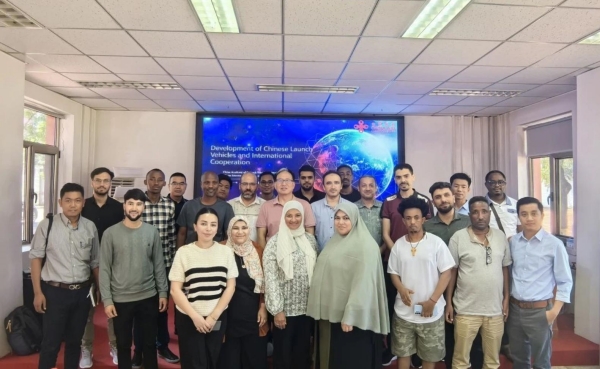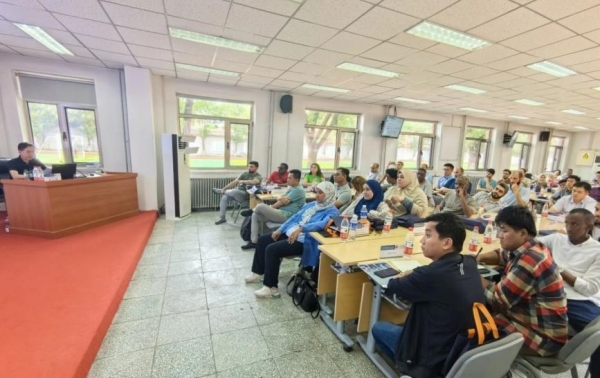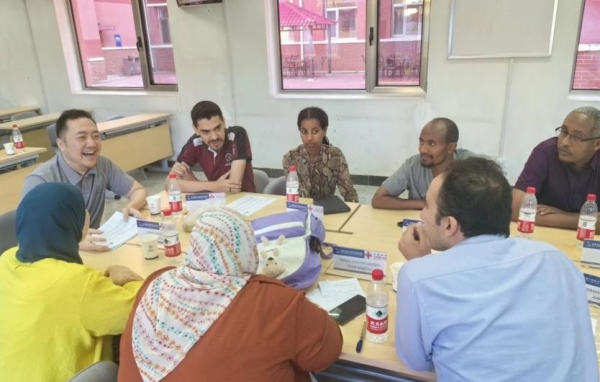The China Academy of Launch Vehicle Technology’s Long March Training Center hosted the first batch of trainees under its inaugural international aid training program earlier this month.
The first 36 participants were all professionals in the aerospace sector and hailed from countries as diverse as Afghanistan, Egypt, Ethiopia, Myanmar and Rwanda.

Some of the participants on the Long March Training Center’s first international aid training program [Photo/sasac.gov.cn]
Since the Long March series rockets made their debut in the 1990s, China has been committed to providing comprehensive commercial satellite and launch services to developing countries. These longstanding partnerships have yielded fruitful results, setting a benchmark for South-South cooperation in the high-tech sector.
In May of this year, the successful launch of the Chang’e 6 probe by the Long March 5 rocket, which also carried a Pakistani CubeSat, drew widespread international attention. This event further solidified China's image as a cooperative and mutually beneficial partner for developing nations in the field of space exploration.
Now, the Long March training program provides opportunities for young aerospace professionals from BRI countries to engage with China’s space endeavors.
An “extraordinary” new model of international cooperation
On the first day of training program, which ran from August 4 to 7, many participants stepped into the Long March center for the first time, and they were consequently keen to get photos with the models of Long March series rockets on display in the lobby.

Participants are introduced to cutting-edge aerospace technology and basic theories of systems engineering. [Photo/sasac.gov.cn]
Many participants were experiencing China’s aerospace industry up close for the first time and the warm reception they received from the Academy of Launch Vehicle Technology and the introduction to cutting-edge aerospace technology and basic theories of systems engineering made their journeys worthwhile.
“In the past, our international cooperation mainly involved exporting technology and products to relevant countries,” said Shan Wenjie from the International Liaison Office of the academy's International Business Department, “But now we recognize the strong demand and urgent desire among many BRI countries to develop their own aerospace industries and enhance their space technology capabilities.”
“We realized that, in this new era of international cooperation, we need to focus more on sharing knowledge and experience and work towards building a closer, more equal and mutually beneficial network of international cooperation.”
During the training, participants had the opportunity to examine new-generation information and communications technology products and solutions, and study the development of the satellite internet industry and related key technologies.
Creating a high-quality curriculum
The main focus of the academy’s first training program was a workshop on “Space Quality Management and Systems Engineering for Developing Countries”. Lectures on topics such as “Space Quality Management and Systems Engineering”, “Space Systems Engineering and Spacecraft” and “China's Long March Series Rockets and International Cooperation” were among the highlights.
Over the past six decades, the academy has accumulated a wealth of experience in quality management and systems engineering, creating a unique and valuable repository of expertise.
“The theories and methodologies of systems engineering management, key to the continuous success of China's aerospace industry, have broad applicability and vitality in the international space field,” said training team leader Lyu Lin.
“Now, we have refined and systematized these practices as a core part of the training program, aiming to promote deeper international exchange and cooperation in the space industry, allowing the wisdom and experience of China’s aerospace sector to blossom in more BRI countries.”
The workshops were organized on the basis of customization, professionalism and standardization and the academy aims to make these the main themes as it undertakes national training programs.
Deepening cooperation for a shared space dream
“What would you name your country’s rocket?” This question, posed during the final exchange and discussion session by three senior engineers from the International Business Department, sparked lively debate among the participants.
“I would name our rocket Ramses after one of our most famous pharaohs,” said a participant from Egypt. Another added, “We would choose a name that reflects our cultural heritage and our dreams of reaching the stars.”

A group discussion during the training program [Photo/sasac.gov.cn]
The question not only encouraged participants to think about the future of their own space programs but also highlighted the shared aspirations of Belt and Road countries to contribute to humanity's exploration of space.
As the first international training project hosted by the academy, this initiative represents a significant step forward in China's international aerospace cooperation efforts. By sharing its expertise in space technology and systems engineering with Belt and Road countries, China is fostering a new model of international collaboration that is rooted in mutual respect, shared interests and a commitment to collective progress.
Moving forward, the China Academy of Launch Vehicle Technology intends to deepen its cooperation with BRI countries, providing more opportunities for young aerospace professionals to participate in training programs and collaborative projects.
(Executive editor: Zhu Zeya)